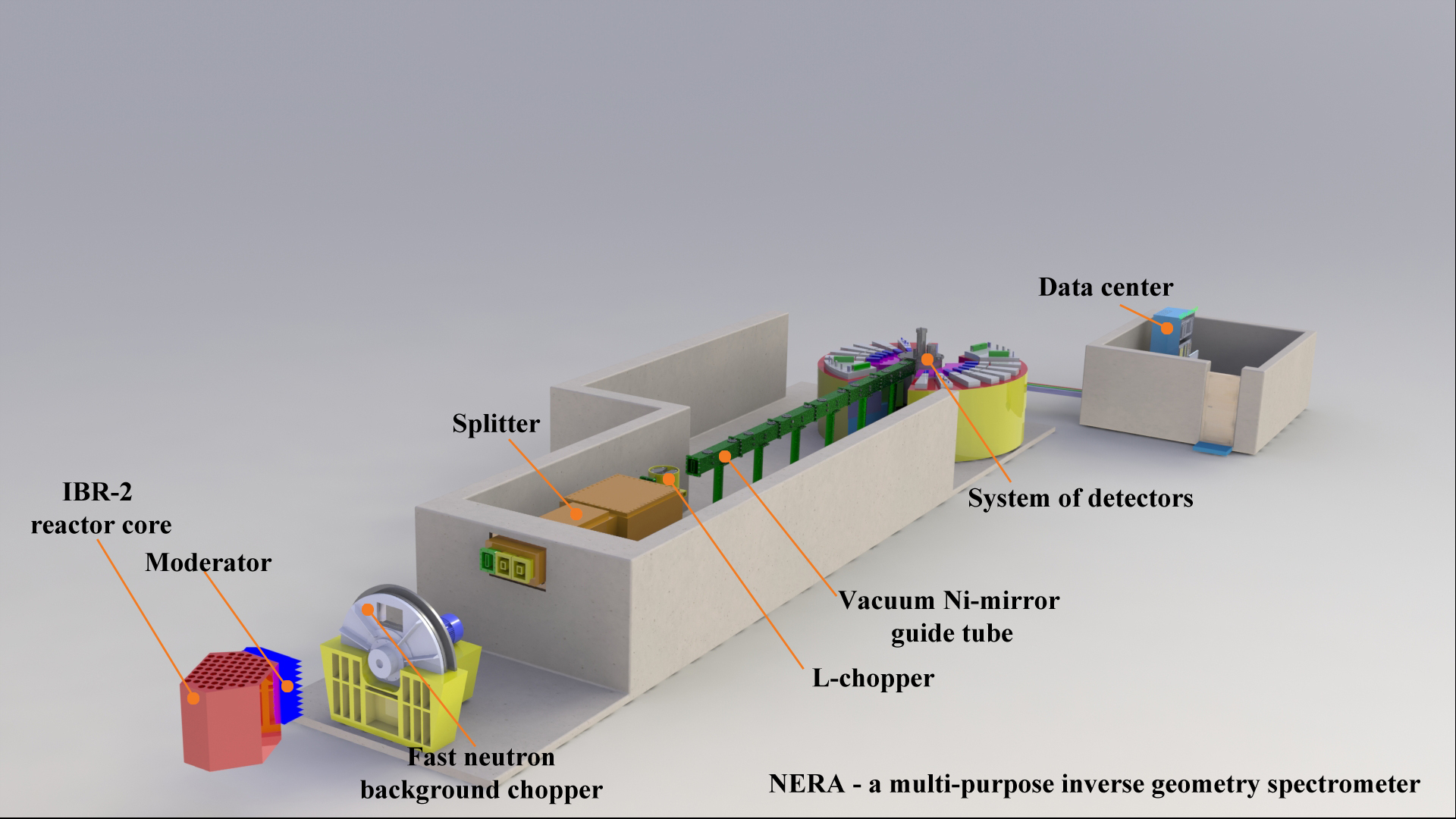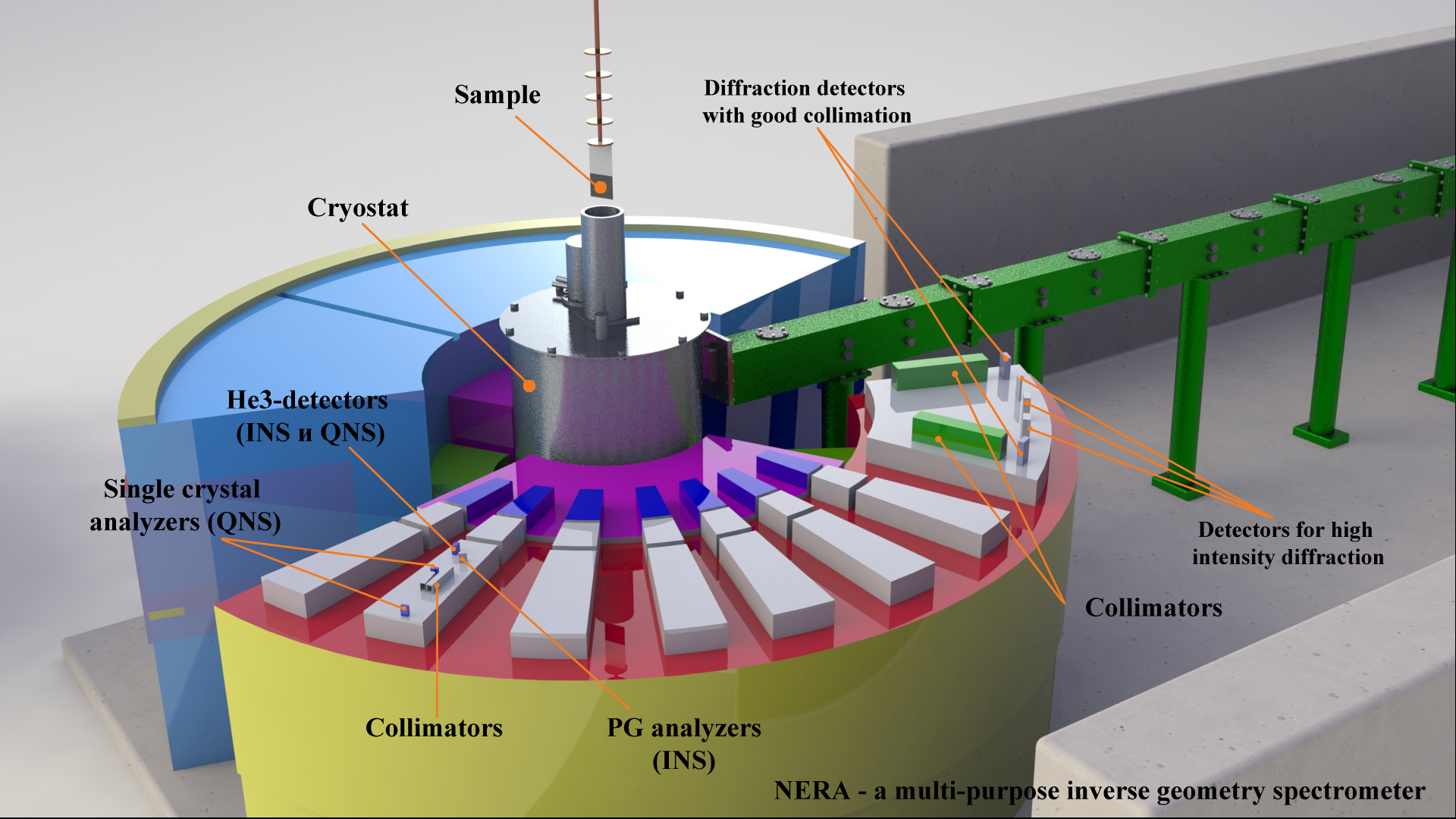Responsible for the facility
Goremychkin Evgeny
Russia, Moscow reg., Dubna, Joliot-Curie str., 6
tel. +7 (49621) 6-54-86
e-mail: This email address is being protected from spambots. You need JavaScript enabled to view it.
Instrument Co-Responsible:
Chudoba Dorota
Russia, Moscow reg., Dubna, Joliot-Curie str., 6
tel. +7 (49621) 6-50-96
e-mail: This email address is being protected from spambots. You need JavaScript enabled to view it.
Main research areas
1. Molecular dynamics of hydrogen-containing compounds, including pharmacological substances.
2. Atomic dynamics and structure of condensed matter, in particular, the investigation of substances with phase polymorphism;
3. Investigation of the magnetic and atomic dynamics of highly correlated systems.
Facility layout
Main view of facility
Sample environment
Description of NERA:
The NERA spectrometer is designed to measure the spectra of elementary excitations in condensed matter that provide relevant data about interatomic interactions at the microscopic level that allows the most precise determination of the physical model of atomic/magnetic dynamics/structure of the substance under investigation, using advanced phenomenological and ab initio models, as well as quantum chemical calculations.
In experiments on inelastic neutron scattering (INS), the change in energy and momentum transferred using a neutron during its interaction with the subject of research is measured.
The NERA spectrometer is a reverse geometry instrument and below is a description of its components and their functionality. After a neutron pulse is produced in the reactor core, the neutrons pass through the moderator, in which they are converted (slowed down) from fast to thermal ones. To suppress the background of fast neutrons (not all fast neutrons are slowed down to thermal ones) and the satellite peak, a chopper is positioned at a distance of 5.5 m. Behind it is a splitter that splits the initial beam of thermal neutrons into three. It allows to have three independent instruments on one beamline and, accordingly, to carry out three different types of experiments simultaneously. Next, the beam passes through a lambda chopper that allows to cut out the desired part of the incident neutron spectrum. Neutrons are delivered to the sample node of the spectrometer via a mirror neutron guide in a vacuum casing. The neutron guide consists of two parts: the first part is 75 m straight with a constant beam cross section of 16x5 cm and the second part is 25 m vertically converging with an input cross section of 16x5 cm and an output cross section of 5x5 cm. After scattering on a sample in a cryostat (this allows to shift the sample temperature in a wide range from 5 to 300), neutrons pass through an energy analyzer that consists of a cooled beryllium filter and an analyzer crystal produced of highly oriented pyrolytic graphite and thus passing neutrons with a final energy of 4.65 meV to the detector. Since the NERA spectrometer is in inverse geometry where the sample is irradiated with a white neutron beam, the installation of detectors without an energy analyzer allows to carry out measurements of neutron diffraction. At the same time, NERA possesses two types of diffraction detectors: with collimation (high resolution) and without collimation (high intensity). This allows to analyze the phase state of matter simultaneously with inelastic scattering.
Thus, the NERA spectrometer allows to simultaneously measure two types of spectra: inelastic (dynamics of the substance under investigation) and diffraction (structure). This allows it to be used to investigate a wide range of materials, from molecular crystals, hormones and biologically active substances to ferroelectrics, electrochemically active substances and fullerenes.
A detailed description of the NERA spectrometer is presented in (1).
Main characteristics Input 50×160 mm2 Output 50×50 mm2 Thermal neutron flux on the sample Sample - detector distance
Neutron guide
Mirror, vacuum
Transverse dimension of the neutron guide
4.6×106n/cm2/s
Wavelength range
0.8-7.0 Å
Scattering angles range
10o-170o
Energy transfer range (INS)
1-160 meV
Solid angle in inelastic scattering experiments
~ 0.2 sr
Moderator - sample distance
109.5 m
0.815 m (INS with Be-filter)
1.015 m (INS with single crystal)
1.415 m (neutron diffraction)
Resolution
Inelastic scattering
see Fig. 4
Neutron diffraction
Δd/d=0.4% для l>1 Å
Sample environment
Closed cycle helium refrigerator (4-300 K). High pressure chamber up to 10 kbar
References
- Natkaniec, D. Chudoba, Ł. Hetmańczyk, V.Yu. Kazimirov, J. Krawczyk, I.L. Sashin and S. Zalewski ‘Parameters of the NERA spectrometer for cold and thermal moderators of the IBR-2 pulsed reactor’ Journal of Physics: Conference Series 554 (2014) 012002
- Z. Malkin, E. A. Goremychkin, K. Siemensmeyer et al, ‘Crystal-field potential and short-range order effects in inelastic neutron scattering, magnetization, and heat capacity of the cage-glass compound HoB12’ PHYSICAL REVIEW B 104,134436(2021)
- Hetmanczyk L., Goremychkin E.A., Waliszewski J., Vener M.V., Lipkowski P., Tolstoy P.M., Filarowski A. ‘Spectroscopic Identification of Hydrogen Bond Vibrations and Quasi-Isostructural Polymorphism in N-Salicylideneaniline’ MOLECULES 26 (16), 5043, (2021)

